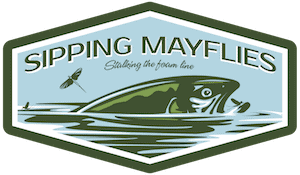MOUSING FOR BROWN TROUT | PATTERNS AND TECHNIQUES
Dec. 2nd, 2021
It’s nighttime and innumerable stars pepper the dark sky. It’s quiet—just the sound of the meandering river, and excited coyotes in the distance. Monster brown trout are actively hunting the very water where you stand. You can’t see them, but they’re there.
This is night fishing for trophy brown trout.
What is Mousing for brown trout?
“Mousing” for trout is a specialized form of fly fishing. Specifically, it’s the act of using a large, floating mouse imitation pattern (fly) on a river, stream, or lake to lure big fish—usually aggressive brown or rainbow trout—to strike.
The reason you use a mouse imitation pattern is because trophy trout eat big prey items—it’s really that simple. Rodents often enter waterways—both accidentally intentionally—where they become prized, calorie-packed meals for fish.
Mousing is usually an activity tailored to catching huge brown trout (Salmo trutta) but can also be effective for hooking into large rainbow trout (Oncorhynchus mykiss).
Years ago I thought mousing must be a long-shot strategy. I mean, how often do trout actually eat mice? I’d never seen it happen.
Well, it happens at night, and it happens a lot.
Check out the stomach contents of this modest-sized rainbow trout, courtesy of the USGS.

Where should I mouse for brown trout?
Rivers and streams are the best locations when mousing for big brown trout. Ideally, the water will have some movement, but not too much. You’ll want to avoid faster and more turbulent water such as riffles and pocket water. Your focus should be on pools and runs with mild to moderate current.
Depth-wise, you’ll want water that’s shallow, in the 1-3 foot range. Nice and wadable. The biggest brown trout are usually found in the shallower sections at night, not the deeper areas.
If you’ll be wading, make sure the river has stretches that will allow you to freely make a backcast without getting tangled in trees and bushes.
According to the US Geological Survey, brown trout are found in nearly every U.S. state, with the exceptions of Florida, Mississippi, and Alaska. Yes, they’re even found in Hawaii on the island of Kauai. Browns can tolerate warmer water than rainbow and brook trout.
Here’s a range map for your reference.
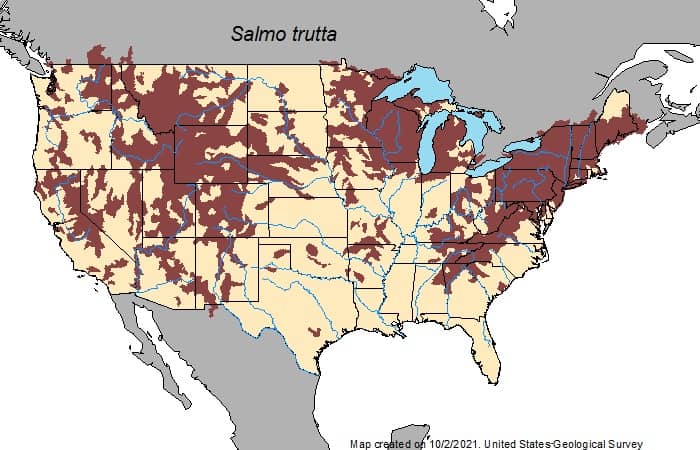
When should I cast mouse patterns?
Despite what you might’ve heard, mousing for brown trout isn’t just a nighttime activity. Your chances of using a mouse pattern to hook into a big brown increase at night, for reasons I’ll detail below, but daytime mousing can be productive too.
Personally, I prefer to start fishing at dusk, then head in around 2am. But I know people who start at 2am-3am and fish until dawn.
One of the biggest advantages of mousing for trout at night is you’re never, ever going to run into other fly anglers. You’ll have the river to yourself.
Mousing is usually most productive from late Spring to late Fall, and any time water levels rise suddenly. (Higher water levels effectively sweep prey items into the water.) You can mouse during the winter, but water temperatures can become an impediment.
Brown trout will be active and feeding in water temperatures between 46F and 68F. Below this range, they slow down and don’t feed as actively. Above this range, they can become stressed.
The most ideal temperature to mouse for feeding brown trout is 52F to 68F. Tailwaters (rivers fed by a reservoir) are going to have the most consistent water temperatures and are your best option if you’ve got the itch during the cold season.
If you’ll be mousing at night, make sure it’s on a river you know very well. The deep spots, the currents, all of it. It’s also smart to go with other people. Be safe.
Joe Humphreys says the best nights, when the really big fish are feeding, are pitch dark. Here’s Joe with his 34-inch Pennsylvania state record brown trout. It was caught a little after 1am.
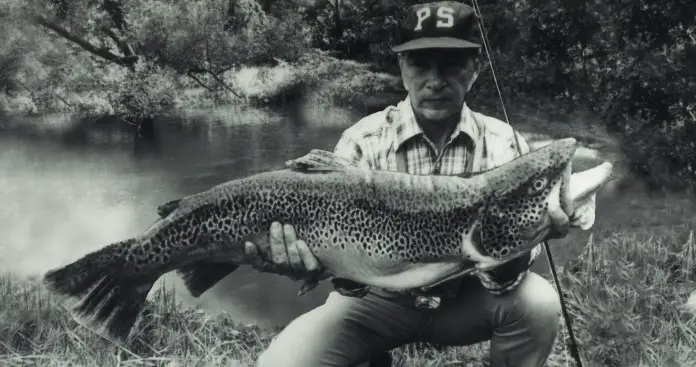
Are Brown Trout Nocturnal?
Small to medium-sized brown trout are primarily diurnal, meaning they’re most active and feeding during the daylight hours, specifically while insect hatches are occurring. Large brown trout are most active at night, often traveling long distances in search of big prey items.
What do I mean by “large” brown trout? There’s no specific definition, but I’d say any fish at or above 22-inches in length. I’ve caught plenty of 20-inch browns in the middle of the day, so they’re clearly not primarily nocturnal. But something happens once they hit that 22-inch range.
Now, large browns aren’t strictly nocturnal—you can catch them on big streamers in the middle of the day. I’ve seen big predatory brown trout chase smaller brown trout under the bright midday sun. But they do tend to do most of their hunting at night.
In an very detailed article I wrote about fly fishing for brown trout, I retold something I learned at a private fly fishing club where I was a member. The owner of the club told me a fellow fly angler had recently landed a big brown trout at dusk, but the fish was bleeding badly.
Instead of throwing the fish back into the water where it would’ve surely died, he dispatched the fish and cut open its belly to see what it had been eating. He found six small mice in the trout’s stomach.
That story changed the way I thought about brown trout. It should open your mind too.
If night fishing isn’t your thing, you can still land big brown trout throwing mouse patterns during the daylight hours. But if you’re not averse to fly fishing at night, it’s without question the most optimal time to chase the big ones.
Mouse Fly Patterns for brown trout
I couldn’t even venture a guess as to how many different mouse patterns I’ve seen online and in fly shops. Most of them have ears, whiskers, a nose, and cute little eyes. They look like cat toys. It’s embarrassing.
Your mouse pattern will be floating on the surface in the darkness of night. The trout won’t be inspecting it for eyes, ears, or whiskers.
There’s no need to agonize over your fly selection. Just buy a Master Splinter mouse pattern and be done with it. It’s inexpensive, and it works really well. And if you’re into fly tying, it doesn’t get much simpler.
Here’s a large brown I caught in the evening on a master splinter mouse pattern. The trout hit the fly about six feet from the shoreline.
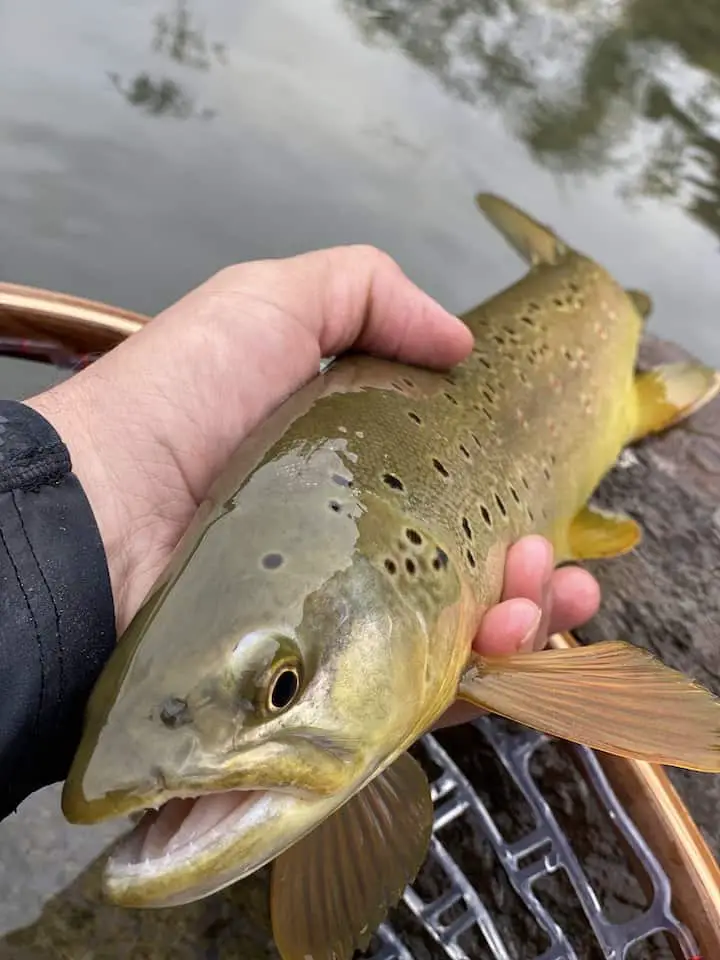
Mousing techniques for brown trout
First, I’ll quickly talk about the daylight hours.
The most successful technique I’ve found for mousing during the daytime is to stand in the middle of the river and cast my mouse pattern 90-degrees towards the shoreline, getting it as close to the shore as possible.
Then, as the current pulls my fly downstream, I start slowly stripping the mouse back to my position. Don’t strip it quickly. There’s no need to mend since drag doesn’t matter–you want movement.
When I’m mousing at night, which is most of the time, my strategy changes.
Do you remember when I mentioned that big brown trout usually hunt at night? They patrol the shallows for prey—I usually find them in 12” to 24” inches of water. Don’t waste time fishing deeper areas with a surface fly.
Let’s get specific.
Big brown trout tend to frequent the inside corners of river bends at night. Why? Because the inside corner is the slower and shallower section in a bend, and it’s where prey animals are more likely to be found. The outside corner of a bend is deeper and faster, and baitfish don’t like it there.
When you find an inside bend, stand upstream and on the same side of the river. Cast your mouse pattern across the water towards the other side of the river and let the current swing your mouse towards the shore of the inside bend.
You don’t need to strip-in any line. Just let the mouse swing around towards the bank.
My anticipation of a strike begins once the mouse swings to within eight feet of the shoreline. This last part of the swing, from eight-feet out all the way to the bank, is when I’m hyper-attentive. This is the strike zone. Buckle-up.
Let’s do some scenario planning.
So, it’s midnight and you’re mouse pattern is about to swing into the strike zone. Your anticipation is building, bordering on electric.
You hear a loud splashing—and it startles you. A monster brown trout just chose your mouse pattern as its next meal.
How do you react?
If your first instinct was to quickly set the hook, you just lost the fish of a lifetime. It’s a common reaction, nothing to be ashamed of.
There’s a saying you may have heard before if you’ve ever fished streamers: “Wait for the weight.” This means you don’t set the hook until you feel the weight of the fish.
Big brown trout violently attack prey on the surface, but they often don’t have the fly ideally situated in their mouth at the moment of impact. Once the trout goes below the surface and you feel its weight, do a solid strip-set.
I’ve learned that this is vital when mousing for brown trout.
Ok, you’ve just set the hook successfully. What’s next?
If you’re thinking you need to prevent your brown from bolting for cover, you get a gold star.
The first thing your fish is going to try to do—and this should go without saying—is head for structure. A downed tree, large rocks, thick weeds—they’re all fair game, and any of them can ruin your evening.
In order to maintain control during the fight, you need the right equipment, which is what we’ll talk about in the next section.
If you do lose a fish, keep your chin up. When you’re mousing, you should expect to cover a lot of water, at least several hundred yards, often more. You’ll get another chance at fish.
Mousing gear and equipment
In my experience, the best mousing fly rod is a 7-weight, at a length of either 8-ft 9-in or 9-ft. The extra strength will come in handy when you’re fighting a big trout, casting into the wind, or using extra large patterns.
This fly rod can pull double-duty as a perfect streamer (or carp) rod too.
Choose a fly line that’s either 7-weight or 8-weight. I highly recommend the Magnum glow line from Scientific Anglers. It’s got a weight-forward taper and is overweighted, meaning it’ll load a little easier. It’s the most popular fly line with serious anglers who cast in the dark.
You don’t need, or want, a long leader at night—but you do need a strong one. Just use 4-6 feet of 20lb-25lb Maxima monofilament line. That’s it. Big browns aren’t leader shy at night.
You’ll want a quality reel with a dependable drag system. Monster brown trout don’t always peel line off your reel, but it’s better to have it in place just in case. Buy something brand name—Sage is my favorite, but their reels aren’t cheap. Orvis makes some quality but affordable reels, including the Hydros and the Clearwater models—they’ll do the job just fine.
You should make sure you pack nippers, some extra leaders and tippet, and a good-sized fishing net.
If you rationalize to yourself that you won’t need your fishing net, it’ll negatively affect your performance (ie. confidence) on the water. Trust me, it just does. Always expect you’re going to need your net.
Bring a flashlight, but not a bright one, and don’t shine it towards the water because it can spook the fish. Before turning it on, walk onto the shore and face away from the water.
Wet flies at night
While this article is about mousing for trout, I’d be remiss if I didn’t mention the opportunity that wet flies offer.
Swung wet flies can be really productive at night. In fact, I never go night fishing without them.
The key is to have big pusher wet flies—this means they “push” a lot of water. In other words, they’re big patterns.
Joe Humphreys has a real penchant for night fishing. He does use topwater flies occasionally, but he prefers using subsurface wet flies because he believes really big trout prefer the path of least resistance—eating underwater. He uses big pusher wet flies, as well as sculpin patterns.
Summary
If you’re on the hunt for a trophy brown trout, mousing at night should be your next adventure. Not only can you hook into the brown of a lifetime, but there are going to be other fish that’ll want a piece of your mouse pattern too, even rainbows.
Mousing is an art practiced by few and mastered by even fewer. It’s an opportunity to own the river, and the solitude. Your eyes will adjust, and you’ll soon see a new world come to life.
The dark skies will increase your attentiveness and focus; I can guarantee that when you hear a brown trout smash your mouse, it’s going to be an adrenaline rush! Remember to strip-set.
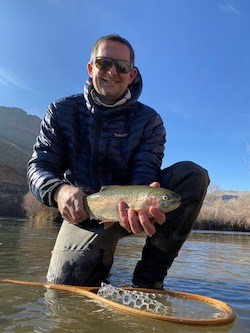
About the Author
My name's Sam and I'm a fly fishing enthusiast just like you. I get out onto the water 80+ times each year, whether it's blazing hot or snow is falling. I enjoy chasing everything from brown trout to snook, and exploring new waters is something I savor. My goal is to discover something new each time I hit the water. Along those lines, I record everything I learn in my fly fishing journal so I can share it with you.
Follow me on Instagram , YouTube, and Facebook to see pictures and videos of my catches and other fishing adventures!
